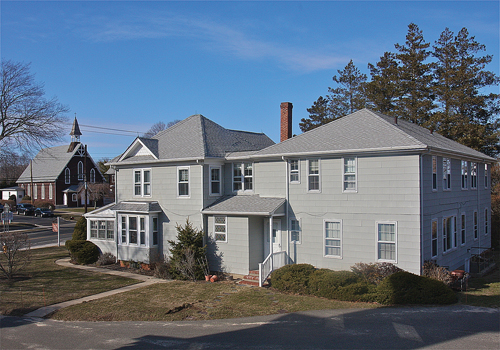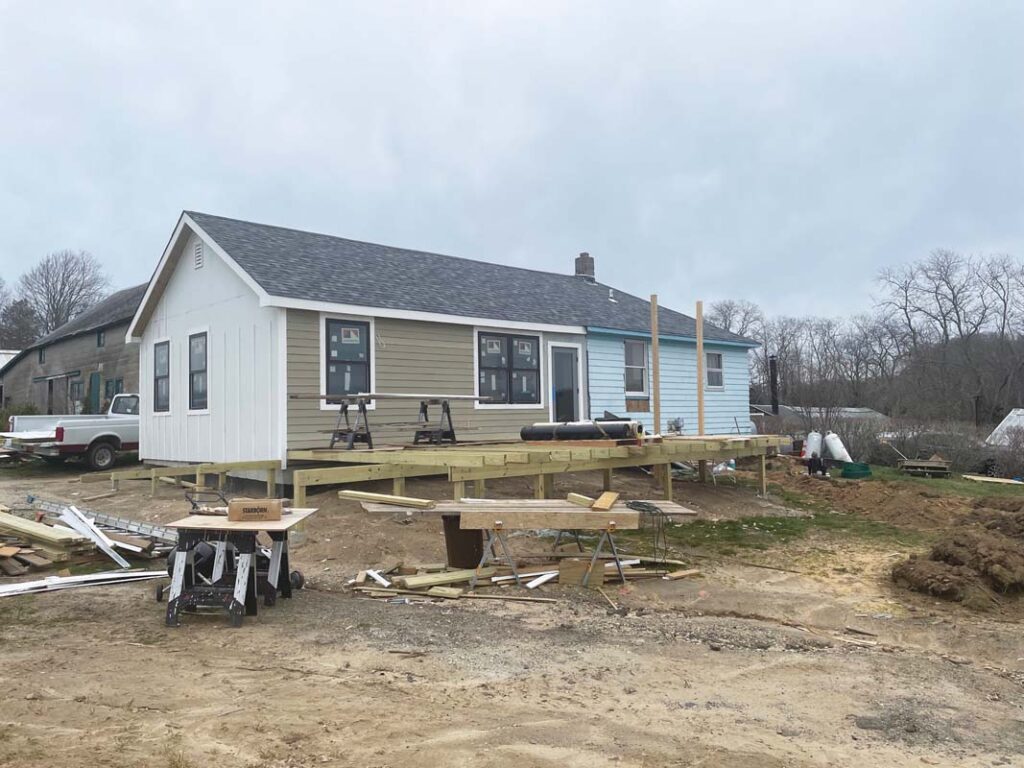Special Report: Sacred spaces headed to market

There was a time, not too long ago, when most families in Southold Town had similar Sunday routines. Each week at about the same time, they would take to the streets with one thought in mind: church. It was a day for people to dress nicely and reflect on their lives and how to improve them. They would gather in church sanctuaries to pray, sing and give thanks to God.
For some congregations, that tradition holds strong today. But others in town are dealing with dwindling attendance — and the everyday reality of trying to keep their church communities intact. With that in mind — and with the news that properties owned by two local congregations are about to hit the real estate market — town officials are considering just what to do if more and more church buildings — including some landmarks — begin to change hands.
“We are not presuming that all churches are closing, but there is a trend emerging,” Southold Supervisor Scott Russell said Friday, a few days after the Town Board discussed the possibility of rezoning church properties that are sold to prevent less-than-desirable transformations.
Religious organizations across not only the town but the nation are questioning whether their properties have outlived their usefulness, as memberships as a whole are trailing off, said James Hudnut-Beumler, a professor of American religious history at Vanderbilt University.
“For decades churches that have declining membership have been seeking to sell off their properties,” he said. “After all, churches in America are built on people gathering together. When that gathering fails is often when these groups get too small to support their churches.”
In response, many are choosing to downsize.
Such is the case with Sacred Heart Parish, which had been operating from both Sacred Heart Church in Cutchogue and Our Lady of Good Counsel Church in Mattituck. Father Joseph Staudt, who leads the Roman Catholic parish, said it has lost about 100 families since he became pastor seven years ago.
Sacred Heart Church closed to parishioners in January 2013 and the church, convent, rectory, parish hall and carriage house in Cutchogue will soon be for sale. Some of the buildings date back to the 1800s; the main church building was built sometime between 1873 and 1878.
“As most people would do when they can’t afford to keep things, we have to start getting rid of property,” Father Joseph said.
The Cutchogue church was closed after an inspection undertaken by the Diocese of Rockville Centre found that the repairs needed to bring the post-and-beam structure up to current safety standards would cost some $2 million. Since the closing, all parish services are being held at Our Lady of Good Counsel, built in the mid-1960s.
The parish is currently having its Main Road buildings appraised and hopes to use profits from their sale to construct a “modest” rectory and parish center next to the church in Mattituck. Our Lady of Mercy Regional School, directly west of the Cutchogue church building, is not being sold, Father Joseph said.
Supervisor Russell said buildings affiliated with another local church, which he would not identify, are also slated to go up for sale in the near future.
“The culture has changed,” Mr. Russell said. “People aren’t joining churches like they used to. Congregations are shrinking. ”
“We compete with sports,” said Celia Iannelli, a warden with Church of the Redeemer Episcopal church in Mattituck. “Today, parents are driving their kids to soccer, to tennis or basketball. That is why the church numbers are going down in general. That is the way it is now. I’m a woman of a certain age, but when I was younger you got dressed up and you went to church on Sunday.”
Church of the Redeemer’s congregation has remained steady through recent years, with about 150 families as members, Ms. Iannelli said.
But, she added, “They don’t all come to church.”
As for national trends, the Pew Research Center has found a gradual decline in religious involvement across the United States. Over the past decade, according to a 2012 Pew study called “Nones on the Rise,” more Americans say they seldom or never attend religious services. The study reported that about 20 percent of the American public — some 46 million people at the time — had no religious affiliation. In addition, according to Pew, the vast majority of religiously unaffiliated Americans are not actively seeking a church or other religious group to join. And the number of so-called religious “nones” increased 5 percent from 2007 to 2012.
The U.S. census stopped collecting information on religious affiliation in 1936.
But even some churches whose leaders consider them to be healthy are concerned about the Town Board’s suggestion that zoning can be changed to limit the ways in which former church properties can be used.
John Nickles, an elder at First Presbyterian Church of Southold, said the church — which is the state’s oldest English congregation — is growing. In the last decade, he said, membership has increased by 25 percent, from 356 members in 2003 to 480 in 2013.
But, he said, should the church’s historic land and properties ever need to be sold, restricting its uses could be “damaging” by decreasing its value.
“It would be to the benefit of churches to profit from the zoning,” Mr. Nickles said. “I don’t think the town should change the zoning.”
He said the property owners should take care to write up restrictions on a church building before selling it off.
“It would save the town the trouble,” he said.
Jamesport Meeting House on the corner of Main Road and Manor Lane in neighboring Riverhead Town is one example of a church building in the region that carries such a covenant; its deed requires that it be used primarily for religious gatherings.
The push to write the restriction came in the 1970s, when the future of the Meeting House, built in 1731, was uncertain. Many in the community feared it would fall into private hands and, even if the initial buyer were dedicated to its preservation, might be resold and transformed into a commercial business — especially since the building sits in the middle of Jamesport’s business district and has Hamlet Center zoning.
Since that covenant was enacted, the Jamesport Meeting House has been leased by several different religious denominations.
It was mostly vacant for four years before the North Fork Unitarian Universalist Fellowship began renting it for regular services in the spring of 2006.
Fellowship treasurer Jere Jacob said it is the covenant that allows the 23-member congregation to rent such a big, beautiful space.
“We are so small in number that we wouldn’t have the opportunity to own a building like that, so to be the favored tenant is terrific,” Ms. Jacob said. “I know what is going on with Sacred Heart and I would like to see that church in use. So I am in favor of the whole rezoning thing” to protect such church buildings.
In the meantime, Father Joseph said the Cutchogue buildings are costing Sacred Heart Parish $2,000 a week for insurance, heating, snow removal and building-maintenance issues.
The parish expects its convent building, located immediately east of Cutchogue New Suffolk Library, across Route 25 from the church and rectory, to sell first.
Father Joseph said he would give first preference to any group looking to preserve the properties, but that money will have to play a large part in the decision.
It would be in the best interest of the congregation to sell the buildings at “fair market price,” he said.
“I want to preserve the church, but I can’t give it away,” he said. “In other words, if someone comes to me and says they’d like to preserve the church, if they offer me less than somebody else … you understand that I owe it to the parish as their leader to make sure that I can get a fair market value for the property and the buildings.” For that reason, Father Joseph said he is wary of Town Board discussions related to rezoning historic church properties.
He fears that putting restrictions on the land use would reduce its worth and deter potential buyers.
“We can’t afford to keep all that we have,” he said.
Father Joseph said he hasn’t been contacted by town officials about any potential code changes.
“I hope the supervisor — and I think he would — would have the courtesy to sit down with me,” he said. “If people want to know something we should have a conversation.”
Mr. Russell later said the town is “looking for reasonable, adaptive re-use” of church buildings.
“There is a larger public purpose for protecting those properties,” Mr. Russell said. “I firmly believe that, generally, church organizations want to see the structures saved and reused in a way that protects the integrity of the structure.”
Mr. Russell said a possible alternative to rezoning would be to create new “special exceptions” in the code that allow church representatives to choose new, town-approved adaptive re-uses for church buildings.
In other parts of the country, church buildings are most commonly sold to other churches, said Mr. Hudnut-Beumler of Vanderbilt. In other cases, he said, they often become schools, art galleries or full-service restaurants.
In order to preserve historic buildings, the community has to play a large role, he said.
“The thing about Long Island is that there are a lot of 17th-century churches that can be impacted,” Mr. Hudnut-Beumler said. “In Suffolk County, the majority of residents would not likely get excited about preservation, but it is your deep history.”
In England, Parliament developed a national registry to protect it historic churches and other structures, he said.
“We are right on the cusp of needing to come up with that sort of thing,” the professor said. “We don’t have quite the government to pull that off.”
The Southold Town Planning Board is now being charged with developing a plan to protect historic churches while keeping them commercially viable if they go on the market, town officials said. That board is expected to work with other town committees and the Landmarks Preservation Commission.








